LMR32 Railway Systems: Analyzing Factors Contributing to Specific Mass
VerifiedAdded on 2023/06/16
|23
|5781
|189
Report
AI Summary
This report delves into the escalating specific mass observed in railway systems, particularly within the United Kingdom, attributing it to factors such as overweight passengers and increased service frequency. It examines the features of the railway system designed to accommodate population needs and presents statistical data illustrating the trend. The report further identifies key challenges arising from this mass increase, including track irregularities and bridge action amplifications, and proposes mitigation strategies to address these issues. Carriage modeling and impulse excitation are discussed in detail, providing a comprehensive overview of the factors influencing railway engineering in the face of growing demands.
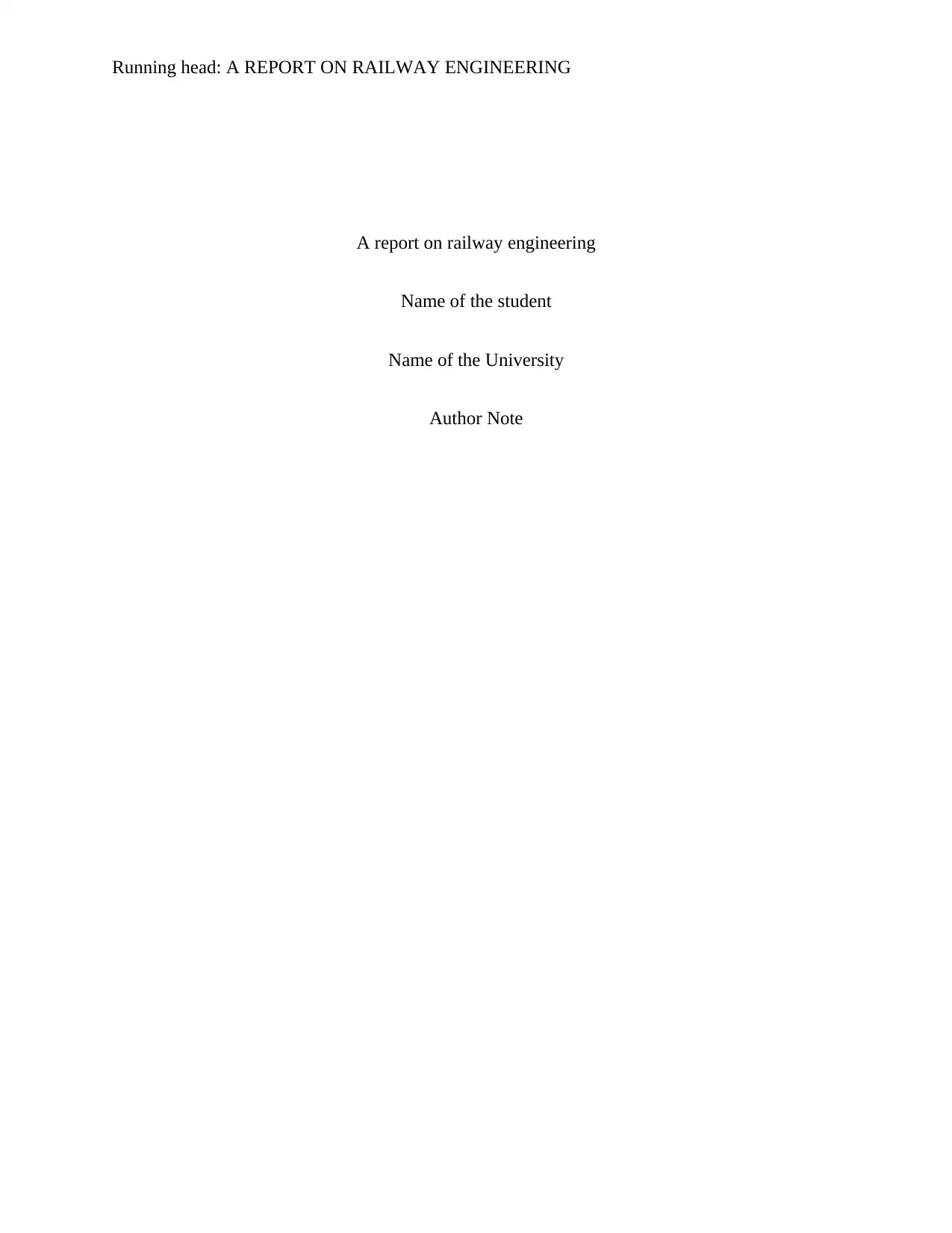
Running head: A REPORT ON RAILWAY ENGINEERING
A report on railway engineering
Name of the student
Name of the University
Author Note
A report on railway engineering
Name of the student
Name of the University
Author Note
Paraphrase This Document
Need a fresh take? Get an instant paraphrase of this document with our AI Paraphraser
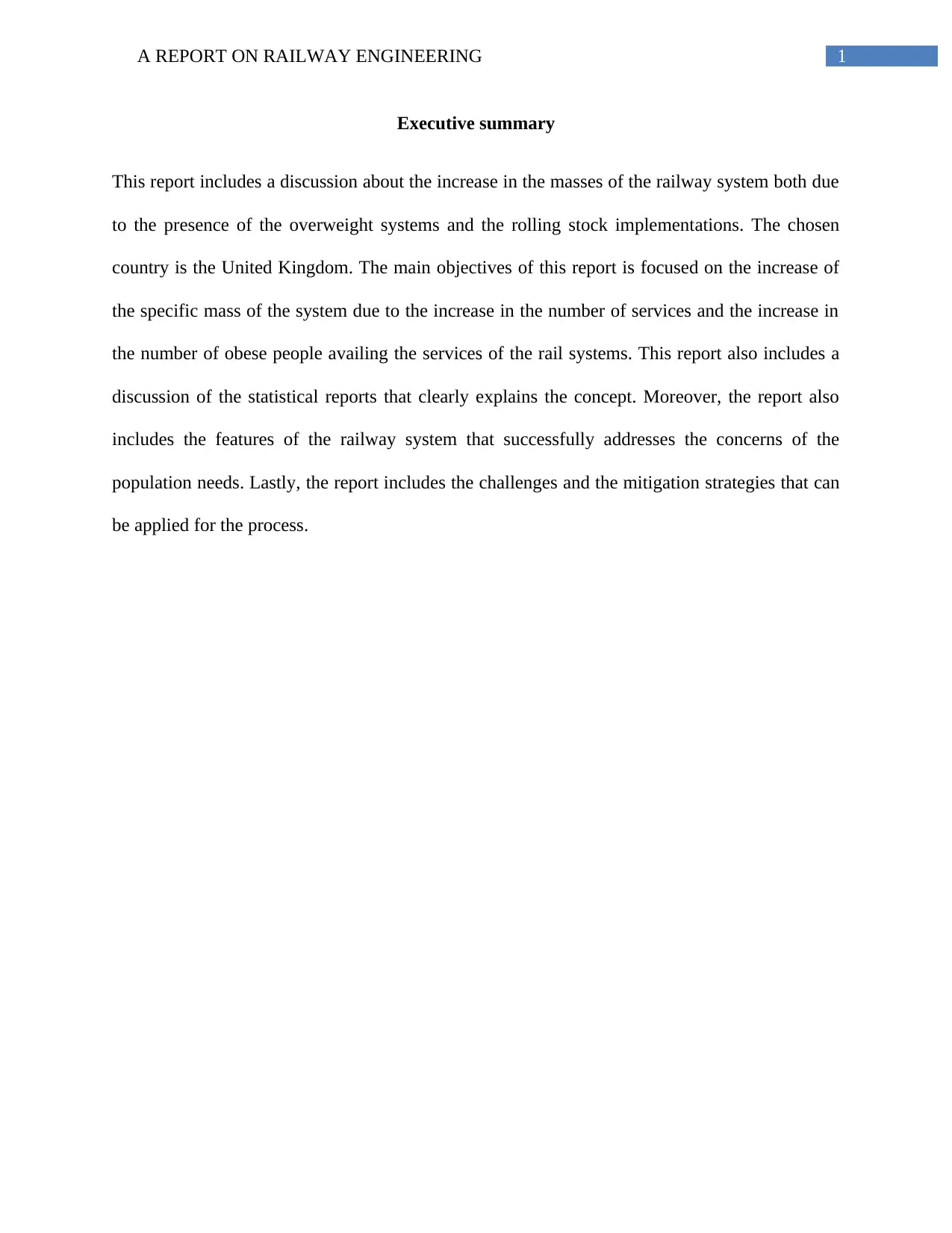
1A REPORT ON RAILWAY ENGINEERING
Executive summary
This report includes a discussion about the increase in the masses of the railway system both due
to the presence of the overweight systems and the rolling stock implementations. The chosen
country is the United Kingdom. The main objectives of this report is focused on the increase of
the specific mass of the system due to the increase in the number of services and the increase in
the number of obese people availing the services of the rail systems. This report also includes a
discussion of the statistical reports that clearly explains the concept. Moreover, the report also
includes the features of the railway system that successfully addresses the concerns of the
population needs. Lastly, the report includes the challenges and the mitigation strategies that can
be applied for the process.
Executive summary
This report includes a discussion about the increase in the masses of the railway system both due
to the presence of the overweight systems and the rolling stock implementations. The chosen
country is the United Kingdom. The main objectives of this report is focused on the increase of
the specific mass of the system due to the increase in the number of services and the increase in
the number of obese people availing the services of the rail systems. This report also includes a
discussion of the statistical reports that clearly explains the concept. Moreover, the report also
includes the features of the railway system that successfully addresses the concerns of the
population needs. Lastly, the report includes the challenges and the mitigation strategies that can
be applied for the process.
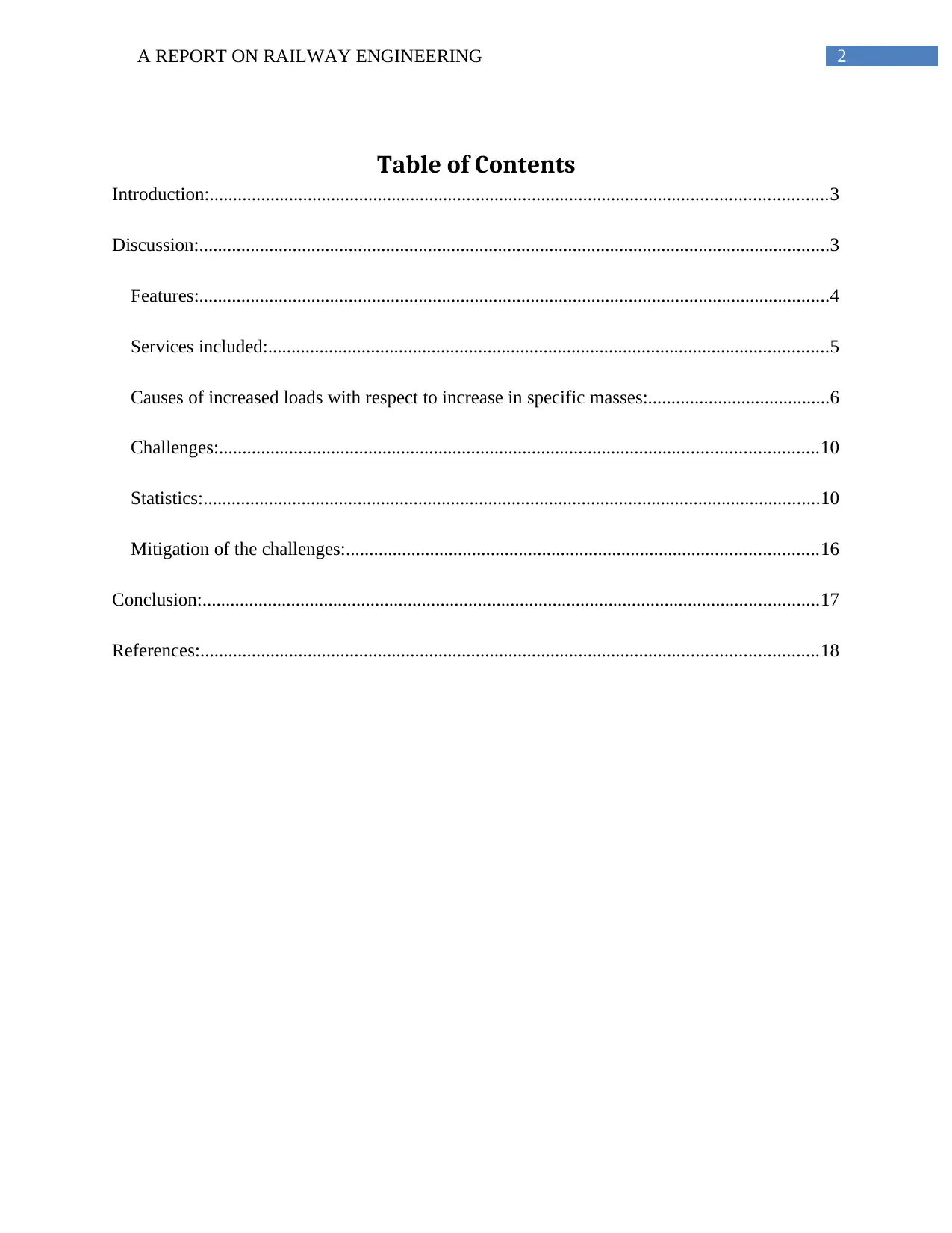
2A REPORT ON RAILWAY ENGINEERING
Table of Contents
Introduction:....................................................................................................................................3
Discussion:.......................................................................................................................................3
Features:.......................................................................................................................................4
Services included:........................................................................................................................5
Causes of increased loads with respect to increase in specific masses:.......................................6
Challenges:................................................................................................................................10
Statistics:....................................................................................................................................10
Mitigation of the challenges:.....................................................................................................16
Conclusion:....................................................................................................................................17
References:....................................................................................................................................18
Table of Contents
Introduction:....................................................................................................................................3
Discussion:.......................................................................................................................................3
Features:.......................................................................................................................................4
Services included:........................................................................................................................5
Causes of increased loads with respect to increase in specific masses:.......................................6
Challenges:................................................................................................................................10
Statistics:....................................................................................................................................10
Mitigation of the challenges:.....................................................................................................16
Conclusion:....................................................................................................................................17
References:....................................................................................................................................18
⊘ This is a preview!⊘
Do you want full access?
Subscribe today to unlock all pages.

Trusted by 1+ million students worldwide
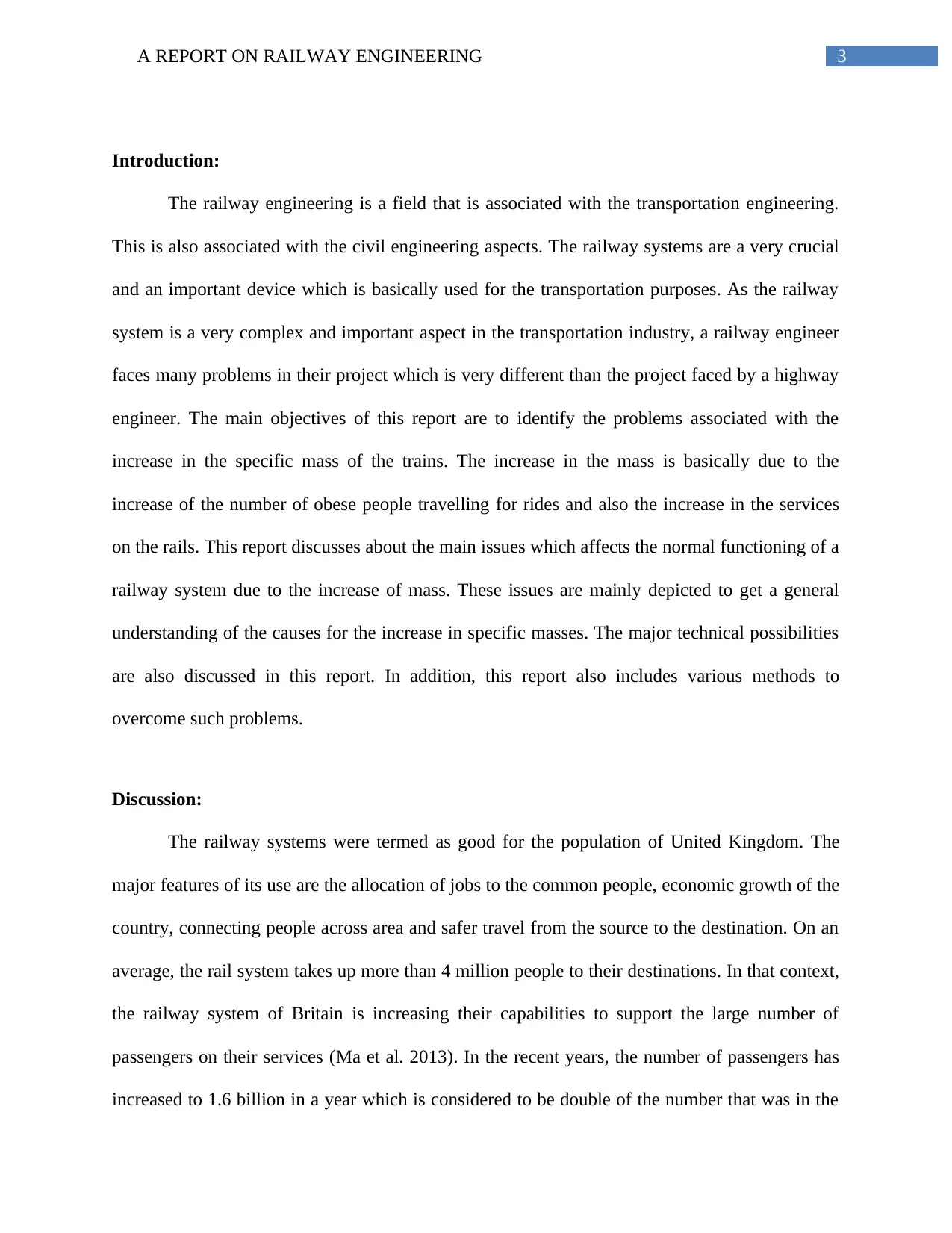
3A REPORT ON RAILWAY ENGINEERING
Introduction:
The railway engineering is a field that is associated with the transportation engineering.
This is also associated with the civil engineering aspects. The railway systems are a very crucial
and an important device which is basically used for the transportation purposes. As the railway
system is a very complex and important aspect in the transportation industry, a railway engineer
faces many problems in their project which is very different than the project faced by a highway
engineer. The main objectives of this report are to identify the problems associated with the
increase in the specific mass of the trains. The increase in the mass is basically due to the
increase of the number of obese people travelling for rides and also the increase in the services
on the rails. This report discusses about the main issues which affects the normal functioning of a
railway system due to the increase of mass. These issues are mainly depicted to get a general
understanding of the causes for the increase in specific masses. The major technical possibilities
are also discussed in this report. In addition, this report also includes various methods to
overcome such problems.
Discussion:
The railway systems were termed as good for the population of United Kingdom. The
major features of its use are the allocation of jobs to the common people, economic growth of the
country, connecting people across area and safer travel from the source to the destination. On an
average, the rail system takes up more than 4 million people to their destinations. In that context,
the railway system of Britain is increasing their capabilities to support the large number of
passengers on their services (Ma et al. 2013). In the recent years, the number of passengers has
increased to 1.6 billion in a year which is considered to be double of the number that was in the
Introduction:
The railway engineering is a field that is associated with the transportation engineering.
This is also associated with the civil engineering aspects. The railway systems are a very crucial
and an important device which is basically used for the transportation purposes. As the railway
system is a very complex and important aspect in the transportation industry, a railway engineer
faces many problems in their project which is very different than the project faced by a highway
engineer. The main objectives of this report are to identify the problems associated with the
increase in the specific mass of the trains. The increase in the mass is basically due to the
increase of the number of obese people travelling for rides and also the increase in the services
on the rails. This report discusses about the main issues which affects the normal functioning of a
railway system due to the increase of mass. These issues are mainly depicted to get a general
understanding of the causes for the increase in specific masses. The major technical possibilities
are also discussed in this report. In addition, this report also includes various methods to
overcome such problems.
Discussion:
The railway systems were termed as good for the population of United Kingdom. The
major features of its use are the allocation of jobs to the common people, economic growth of the
country, connecting people across area and safer travel from the source to the destination. On an
average, the rail system takes up more than 4 million people to their destinations. In that context,
the railway system of Britain is increasing their capabilities to support the large number of
passengers on their services (Ma et al. 2013). In the recent years, the number of passengers has
increased to 1.6 billion in a year which is considered to be double of the number that was in the
Paraphrase This Document
Need a fresh take? Get an instant paraphrase of this document with our AI Paraphraser
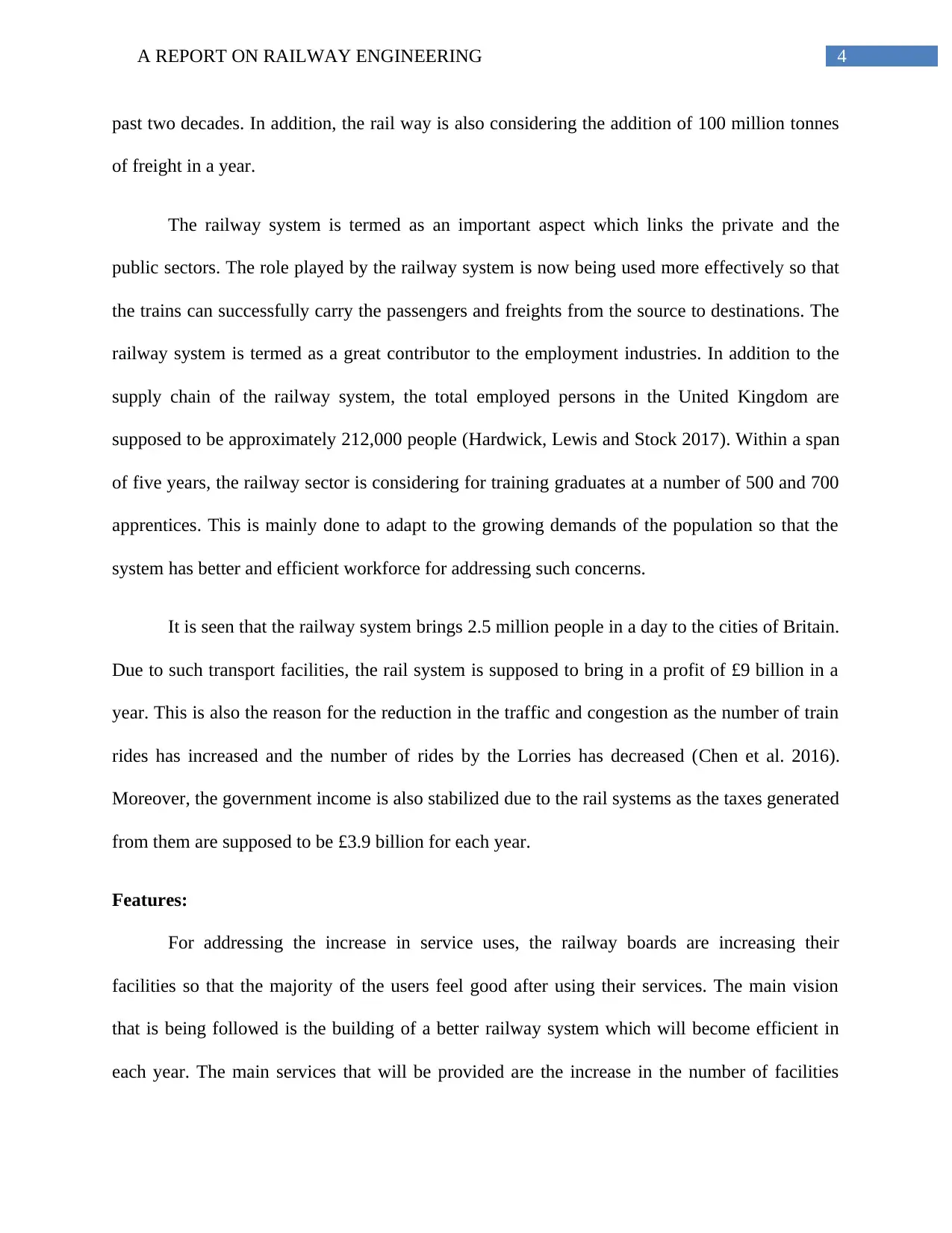
4A REPORT ON RAILWAY ENGINEERING
past two decades. In addition, the rail way is also considering the addition of 100 million tonnes
of freight in a year.
The railway system is termed as an important aspect which links the private and the
public sectors. The role played by the railway system is now being used more effectively so that
the trains can successfully carry the passengers and freights from the source to destinations. The
railway system is termed as a great contributor to the employment industries. In addition to the
supply chain of the railway system, the total employed persons in the United Kingdom are
supposed to be approximately 212,000 people (Hardwick, Lewis and Stock 2017). Within a span
of five years, the railway sector is considering for training graduates at a number of 500 and 700
apprentices. This is mainly done to adapt to the growing demands of the population so that the
system has better and efficient workforce for addressing such concerns.
It is seen that the railway system brings 2.5 million people in a day to the cities of Britain.
Due to such transport facilities, the rail system is supposed to bring in a profit of £9 billion in a
year. This is also the reason for the reduction in the traffic and congestion as the number of train
rides has increased and the number of rides by the Lorries has decreased (Chen et al. 2016).
Moreover, the government income is also stabilized due to the rail systems as the taxes generated
from them are supposed to be £3.9 billion for each year.
Features:
For addressing the increase in service uses, the railway boards are increasing their
facilities so that the majority of the users feel good after using their services. The main vision
that is being followed is the building of a better railway system which will become efficient in
each year. The main services that will be provided are the increase in the number of facilities
past two decades. In addition, the rail way is also considering the addition of 100 million tonnes
of freight in a year.
The railway system is termed as an important aspect which links the private and the
public sectors. The role played by the railway system is now being used more effectively so that
the trains can successfully carry the passengers and freights from the source to destinations. The
railway system is termed as a great contributor to the employment industries. In addition to the
supply chain of the railway system, the total employed persons in the United Kingdom are
supposed to be approximately 212,000 people (Hardwick, Lewis and Stock 2017). Within a span
of five years, the railway sector is considering for training graduates at a number of 500 and 700
apprentices. This is mainly done to adapt to the growing demands of the population so that the
system has better and efficient workforce for addressing such concerns.
It is seen that the railway system brings 2.5 million people in a day to the cities of Britain.
Due to such transport facilities, the rail system is supposed to bring in a profit of £9 billion in a
year. This is also the reason for the reduction in the traffic and congestion as the number of train
rides has increased and the number of rides by the Lorries has decreased (Chen et al. 2016).
Moreover, the government income is also stabilized due to the rail systems as the taxes generated
from them are supposed to be £3.9 billion for each year.
Features:
For addressing the increase in service uses, the railway boards are increasing their
facilities so that the majority of the users feel good after using their services. The main vision
that is being followed is the building of a better railway system which will become efficient in
each year. The main services that will be provided are the increase in the number of facilities
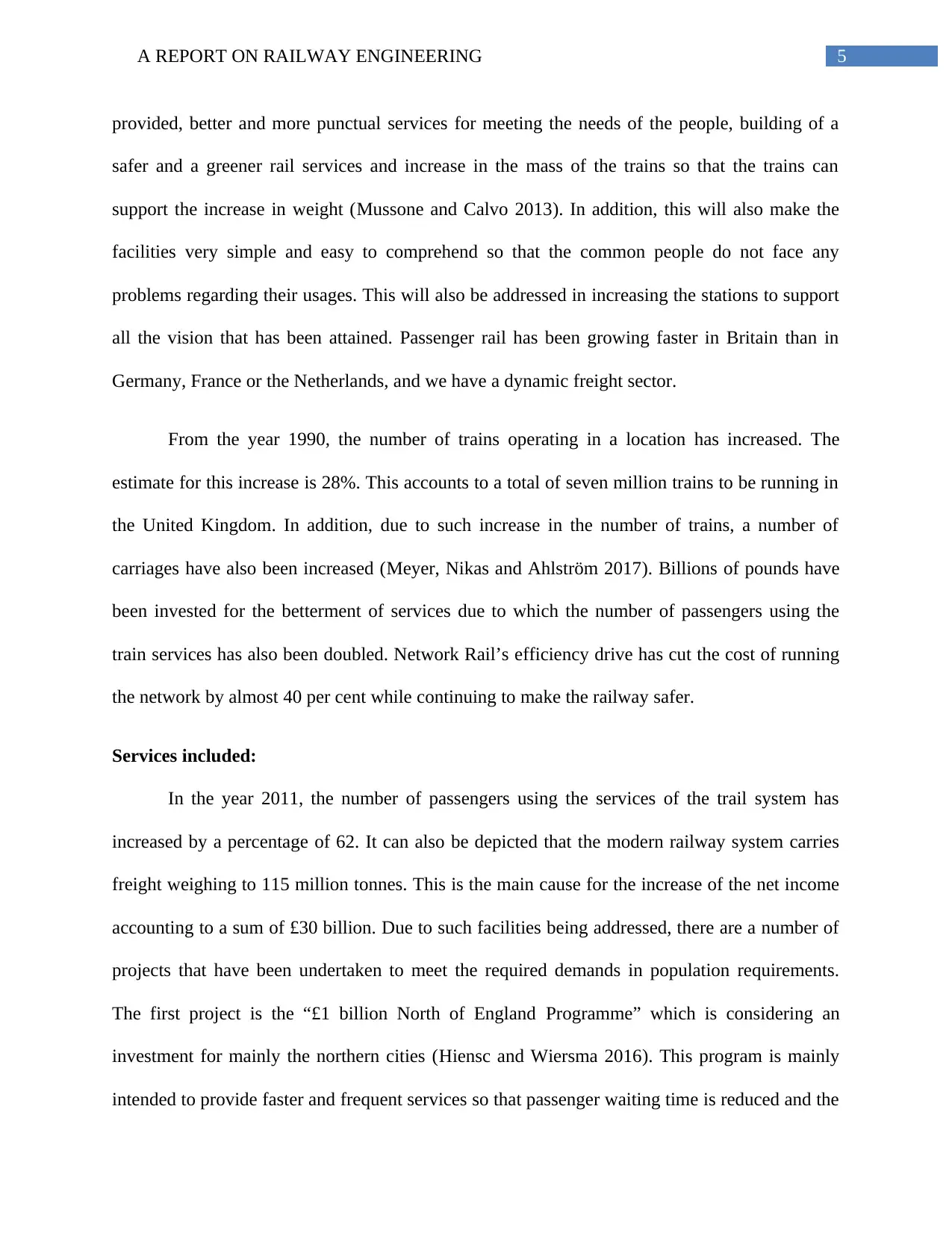
5A REPORT ON RAILWAY ENGINEERING
provided, better and more punctual services for meeting the needs of the people, building of a
safer and a greener rail services and increase in the mass of the trains so that the trains can
support the increase in weight (Mussone and Calvo 2013). In addition, this will also make the
facilities very simple and easy to comprehend so that the common people do not face any
problems regarding their usages. This will also be addressed in increasing the stations to support
all the vision that has been attained. Passenger rail has been growing faster in Britain than in
Germany, France or the Netherlands, and we have a dynamic freight sector.
From the year 1990, the number of trains operating in a location has increased. The
estimate for this increase is 28%. This accounts to a total of seven million trains to be running in
the United Kingdom. In addition, due to such increase in the number of trains, a number of
carriages have also been increased (Meyer, Nikas and Ahlström 2017). Billions of pounds have
been invested for the betterment of services due to which the number of passengers using the
train services has also been doubled. Network Rail’s efficiency drive has cut the cost of running
the network by almost 40 per cent while continuing to make the railway safer.
Services included:
In the year 2011, the number of passengers using the services of the trail system has
increased by a percentage of 62. It can also be depicted that the modern railway system carries
freight weighing to 115 million tonnes. This is the main cause for the increase of the net income
accounting to a sum of £30 billion. Due to such facilities being addressed, there are a number of
projects that have been undertaken to meet the required demands in population requirements.
The first project is the “£1 billion North of England Programme” which is considering an
investment for mainly the northern cities (Hiensc and Wiersma 2016). This program is mainly
intended to provide faster and frequent services so that passenger waiting time is reduced and the
provided, better and more punctual services for meeting the needs of the people, building of a
safer and a greener rail services and increase in the mass of the trains so that the trains can
support the increase in weight (Mussone and Calvo 2013). In addition, this will also make the
facilities very simple and easy to comprehend so that the common people do not face any
problems regarding their usages. This will also be addressed in increasing the stations to support
all the vision that has been attained. Passenger rail has been growing faster in Britain than in
Germany, France or the Netherlands, and we have a dynamic freight sector.
From the year 1990, the number of trains operating in a location has increased. The
estimate for this increase is 28%. This accounts to a total of seven million trains to be running in
the United Kingdom. In addition, due to such increase in the number of trains, a number of
carriages have also been increased (Meyer, Nikas and Ahlström 2017). Billions of pounds have
been invested for the betterment of services due to which the number of passengers using the
train services has also been doubled. Network Rail’s efficiency drive has cut the cost of running
the network by almost 40 per cent while continuing to make the railway safer.
Services included:
In the year 2011, the number of passengers using the services of the trail system has
increased by a percentage of 62. It can also be depicted that the modern railway system carries
freight weighing to 115 million tonnes. This is the main cause for the increase of the net income
accounting to a sum of £30 billion. Due to such facilities being addressed, there are a number of
projects that have been undertaken to meet the required demands in population requirements.
The first project is the “£1 billion North of England Programme” which is considering an
investment for mainly the northern cities (Hiensc and Wiersma 2016). This program is mainly
intended to provide faster and frequent services so that passenger waiting time is reduced and the
⊘ This is a preview!⊘
Do you want full access?
Subscribe today to unlock all pages.

Trusted by 1+ million students worldwide
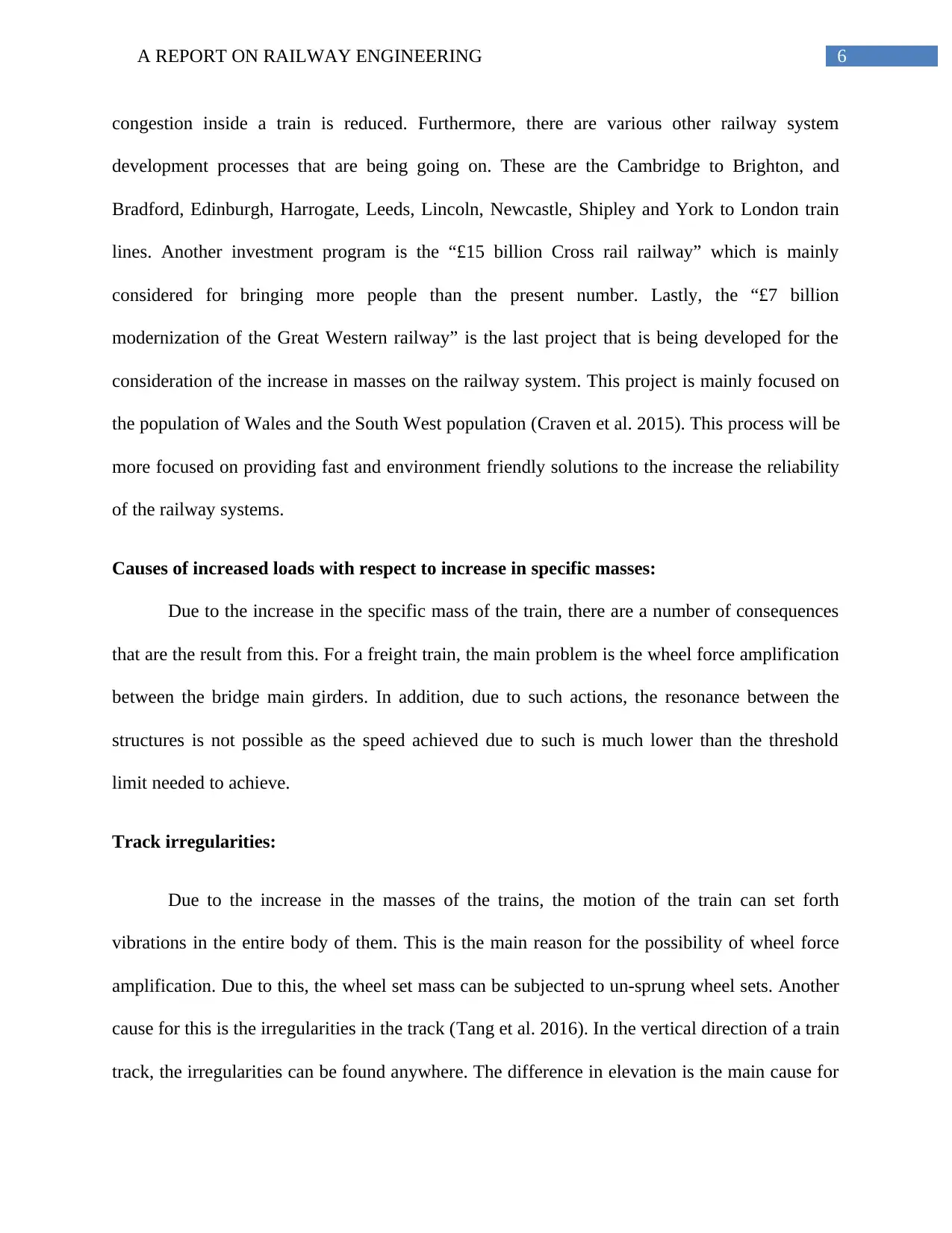
6A REPORT ON RAILWAY ENGINEERING
congestion inside a train is reduced. Furthermore, there are various other railway system
development processes that are being going on. These are the Cambridge to Brighton, and
Bradford, Edinburgh, Harrogate, Leeds, Lincoln, Newcastle, Shipley and York to London train
lines. Another investment program is the “£15 billion Cross rail railway” which is mainly
considered for bringing more people than the present number. Lastly, the “£7 billion
modernization of the Great Western railway” is the last project that is being developed for the
consideration of the increase in masses on the railway system. This project is mainly focused on
the population of Wales and the South West population (Craven et al. 2015). This process will be
more focused on providing fast and environment friendly solutions to the increase the reliability
of the railway systems.
Causes of increased loads with respect to increase in specific masses:
Due to the increase in the specific mass of the train, there are a number of consequences
that are the result from this. For a freight train, the main problem is the wheel force amplification
between the bridge main girders. In addition, due to such actions, the resonance between the
structures is not possible as the speed achieved due to such is much lower than the threshold
limit needed to achieve.
Track irregularities:
Due to the increase in the masses of the trains, the motion of the train can set forth
vibrations in the entire body of them. This is the main reason for the possibility of wheel force
amplification. Due to this, the wheel set mass can be subjected to un-sprung wheel sets. Another
cause for this is the irregularities in the track (Tang et al. 2016). In the vertical direction of a train
track, the irregularities can be found anywhere. The difference in elevation is the main cause for
congestion inside a train is reduced. Furthermore, there are various other railway system
development processes that are being going on. These are the Cambridge to Brighton, and
Bradford, Edinburgh, Harrogate, Leeds, Lincoln, Newcastle, Shipley and York to London train
lines. Another investment program is the “£15 billion Cross rail railway” which is mainly
considered for bringing more people than the present number. Lastly, the “£7 billion
modernization of the Great Western railway” is the last project that is being developed for the
consideration of the increase in masses on the railway system. This project is mainly focused on
the population of Wales and the South West population (Craven et al. 2015). This process will be
more focused on providing fast and environment friendly solutions to the increase the reliability
of the railway systems.
Causes of increased loads with respect to increase in specific masses:
Due to the increase in the specific mass of the train, there are a number of consequences
that are the result from this. For a freight train, the main problem is the wheel force amplification
between the bridge main girders. In addition, due to such actions, the resonance between the
structures is not possible as the speed achieved due to such is much lower than the threshold
limit needed to achieve.
Track irregularities:
Due to the increase in the masses of the trains, the motion of the train can set forth
vibrations in the entire body of them. This is the main reason for the possibility of wheel force
amplification. Due to this, the wheel set mass can be subjected to un-sprung wheel sets. Another
cause for this is the irregularities in the track (Tang et al. 2016). In the vertical direction of a train
track, the irregularities can be found anywhere. The difference in elevation is the main cause for
Paraphrase This Document
Need a fresh take? Get an instant paraphrase of this document with our AI Paraphraser
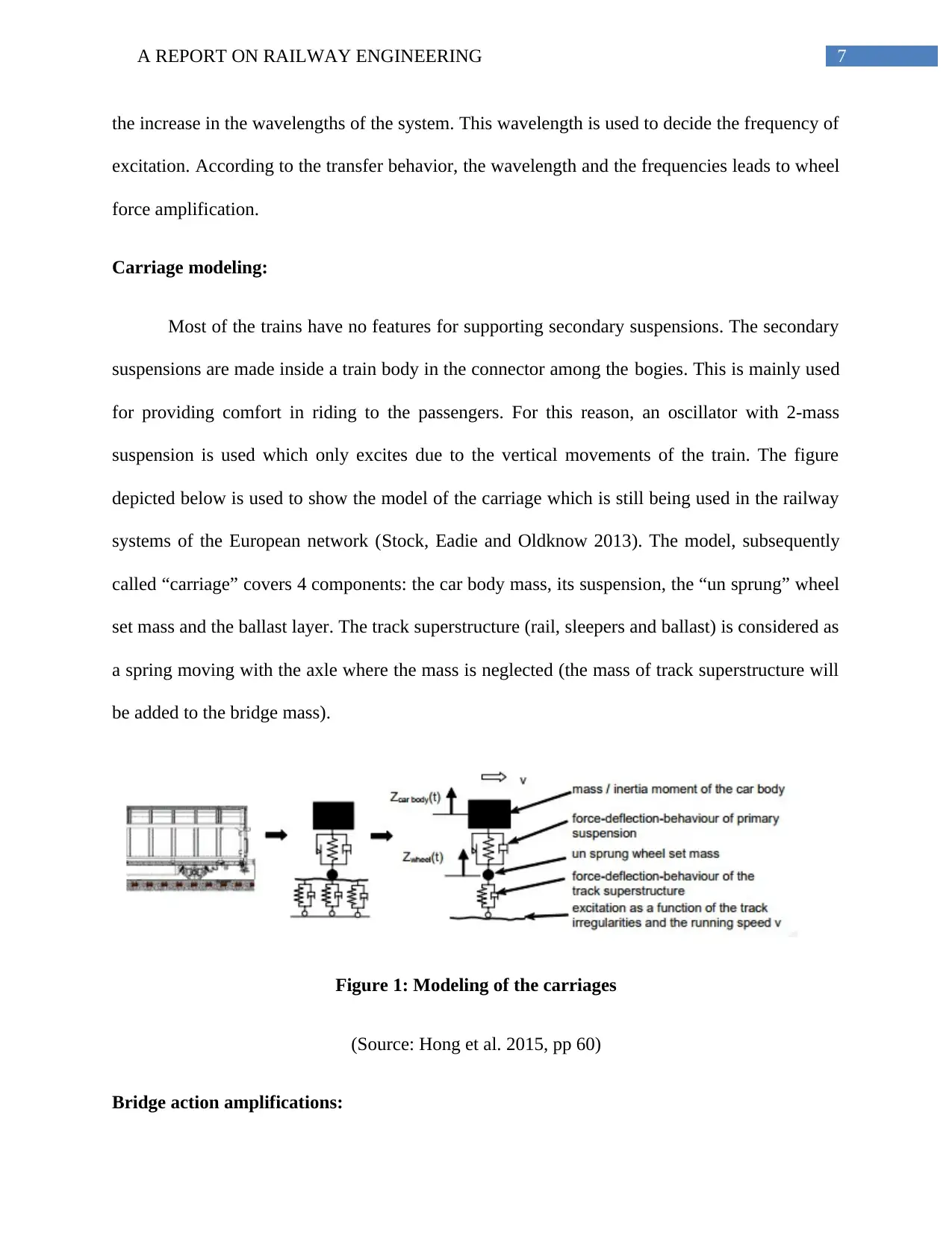
7A REPORT ON RAILWAY ENGINEERING
the increase in the wavelengths of the system. This wavelength is used to decide the frequency of
excitation. According to the transfer behavior, the wavelength and the frequencies leads to wheel
force amplification.
Carriage modeling:
Most of the trains have no features for supporting secondary suspensions. The secondary
suspensions are made inside a train body in the connector among the bogies. This is mainly used
for providing comfort in riding to the passengers. For this reason, an oscillator with 2-mass
suspension is used which only excites due to the vertical movements of the train. The figure
depicted below is used to show the model of the carriage which is still being used in the railway
systems of the European network (Stock, Eadie and Oldknow 2013). The model, subsequently
called “carriage” covers 4 components: the car body mass, its suspension, the “un sprung” wheel
set mass and the ballast layer. The track superstructure (rail, sleepers and ballast) is considered as
a spring moving with the axle where the mass is neglected (the mass of track superstructure will
be added to the bridge mass).
Figure 1: Modeling of the carriages
(Source: Hong et al. 2015, pp 60)
Bridge action amplifications:
the increase in the wavelengths of the system. This wavelength is used to decide the frequency of
excitation. According to the transfer behavior, the wavelength and the frequencies leads to wheel
force amplification.
Carriage modeling:
Most of the trains have no features for supporting secondary suspensions. The secondary
suspensions are made inside a train body in the connector among the bogies. This is mainly used
for providing comfort in riding to the passengers. For this reason, an oscillator with 2-mass
suspension is used which only excites due to the vertical movements of the train. The figure
depicted below is used to show the model of the carriage which is still being used in the railway
systems of the European network (Stock, Eadie and Oldknow 2013). The model, subsequently
called “carriage” covers 4 components: the car body mass, its suspension, the “un sprung” wheel
set mass and the ballast layer. The track superstructure (rail, sleepers and ballast) is considered as
a spring moving with the axle where the mass is neglected (the mass of track superstructure will
be added to the bridge mass).
Figure 1: Modeling of the carriages
(Source: Hong et al. 2015, pp 60)
Bridge action amplifications:
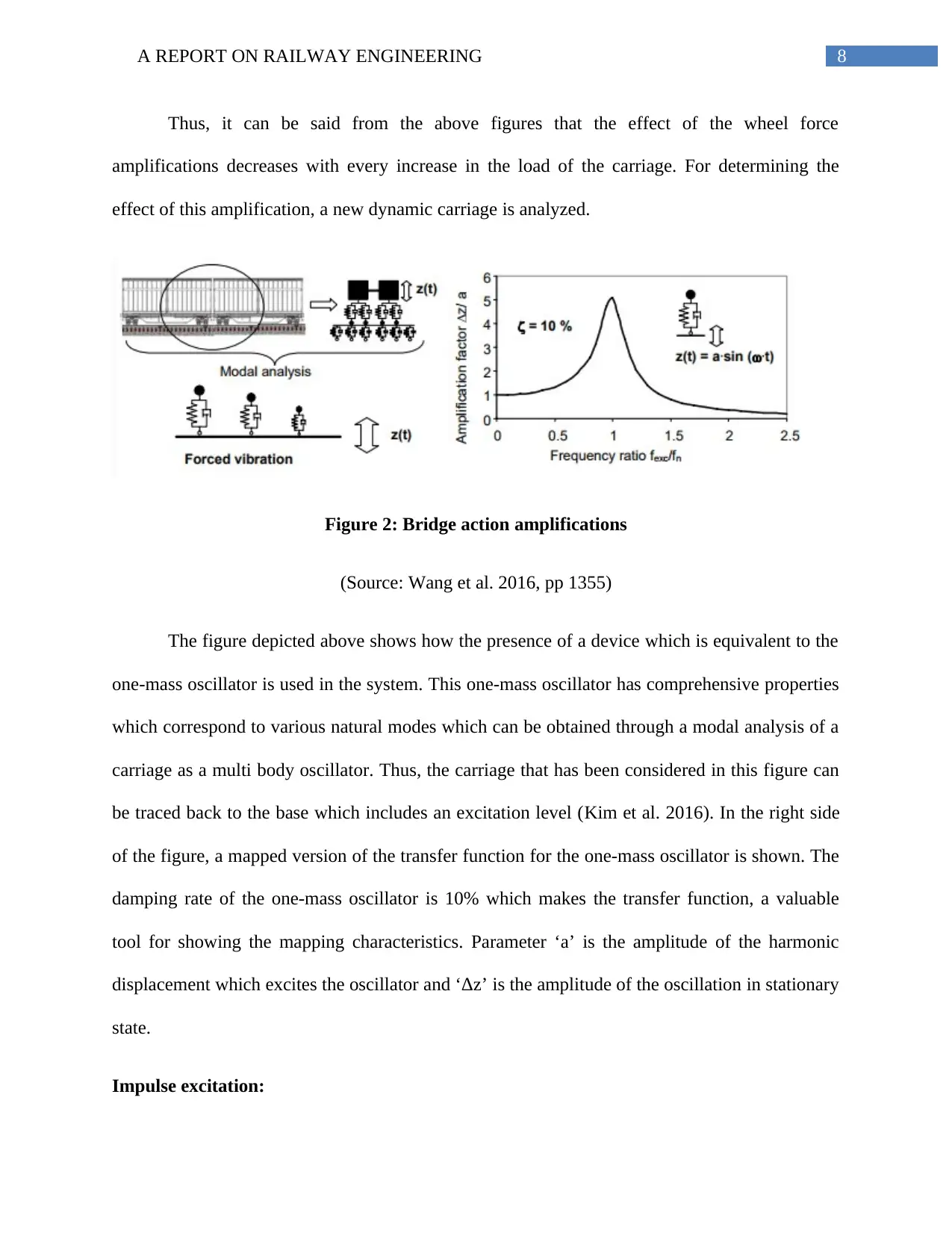
8A REPORT ON RAILWAY ENGINEERING
Thus, it can be said from the above figures that the effect of the wheel force
amplifications decreases with every increase in the load of the carriage. For determining the
effect of this amplification, a new dynamic carriage is analyzed.
Figure 2: Bridge action amplifications
(Source: Wang et al. 2016, pp 1355)
The figure depicted above shows how the presence of a device which is equivalent to the
one-mass oscillator is used in the system. This one-mass oscillator has comprehensive properties
which correspond to various natural modes which can be obtained through a modal analysis of a
carriage as a multi body oscillator. Thus, the carriage that has been considered in this figure can
be traced back to the base which includes an excitation level (Kim et al. 2016). In the right side
of the figure, a mapped version of the transfer function for the one-mass oscillator is shown. The
damping rate of the one-mass oscillator is 10% which makes the transfer function, a valuable
tool for showing the mapping characteristics. Parameter ‘a’ is the amplitude of the harmonic
displacement which excites the oscillator and ‘Δz’ is the amplitude of the oscillation in stationary
state.
Impulse excitation:
Thus, it can be said from the above figures that the effect of the wheel force
amplifications decreases with every increase in the load of the carriage. For determining the
effect of this amplification, a new dynamic carriage is analyzed.
Figure 2: Bridge action amplifications
(Source: Wang et al. 2016, pp 1355)
The figure depicted above shows how the presence of a device which is equivalent to the
one-mass oscillator is used in the system. This one-mass oscillator has comprehensive properties
which correspond to various natural modes which can be obtained through a modal analysis of a
carriage as a multi body oscillator. Thus, the carriage that has been considered in this figure can
be traced back to the base which includes an excitation level (Kim et al. 2016). In the right side
of the figure, a mapped version of the transfer function for the one-mass oscillator is shown. The
damping rate of the one-mass oscillator is 10% which makes the transfer function, a valuable
tool for showing the mapping characteristics. Parameter ‘a’ is the amplitude of the harmonic
displacement which excites the oscillator and ‘Δz’ is the amplitude of the oscillation in stationary
state.
Impulse excitation:
⊘ This is a preview!⊘
Do you want full access?
Subscribe today to unlock all pages.

Trusted by 1+ million students worldwide
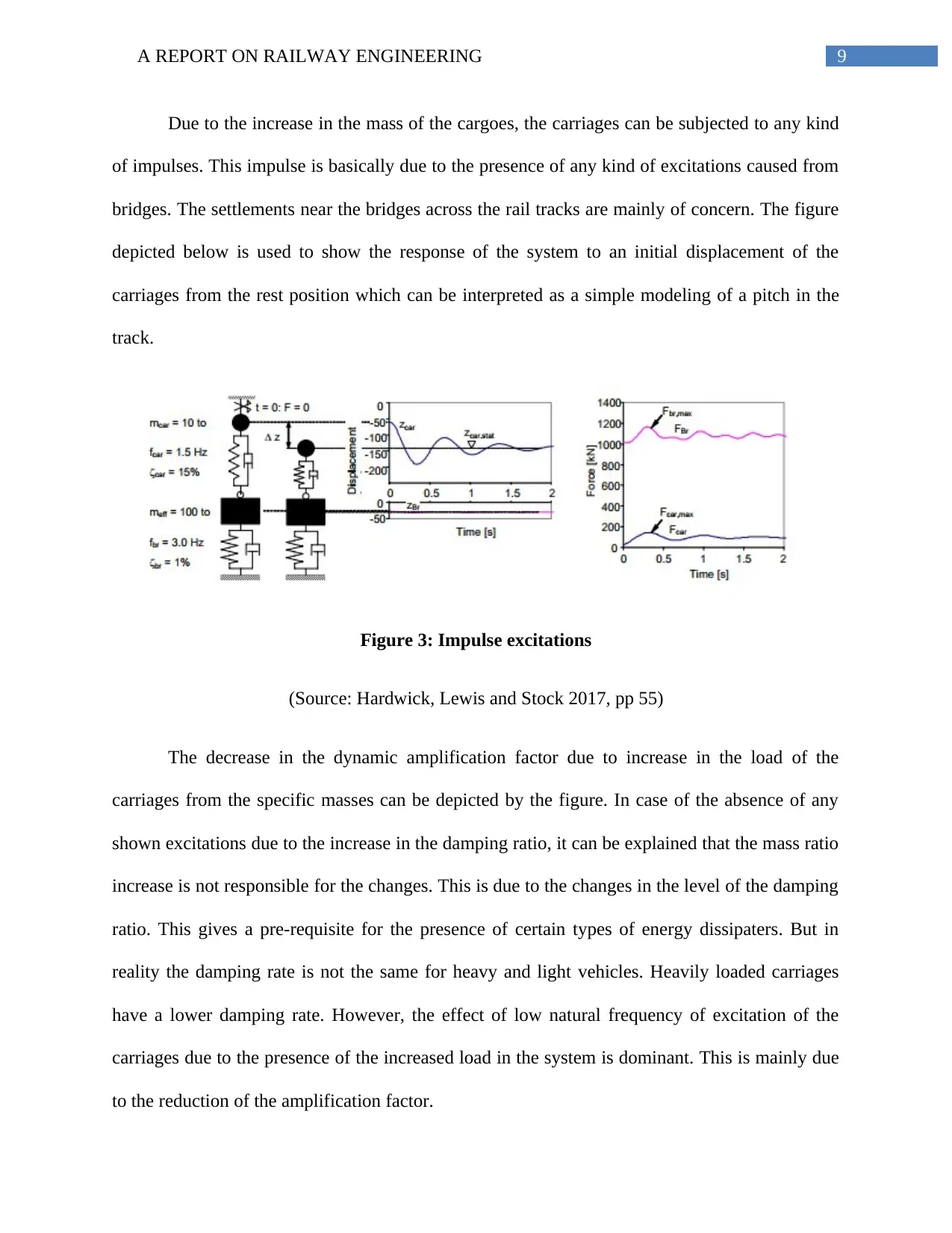
9A REPORT ON RAILWAY ENGINEERING
Due to the increase in the mass of the cargoes, the carriages can be subjected to any kind
of impulses. This impulse is basically due to the presence of any kind of excitations caused from
bridges. The settlements near the bridges across the rail tracks are mainly of concern. The figure
depicted below is used to show the response of the system to an initial displacement of the
carriages from the rest position which can be interpreted as a simple modeling of a pitch in the
track.
Figure 3: Impulse excitations
(Source: Hardwick, Lewis and Stock 2017, pp 55)
The decrease in the dynamic amplification factor due to increase in the load of the
carriages from the specific masses can be depicted by the figure. In case of the absence of any
shown excitations due to the increase in the damping ratio, it can be explained that the mass ratio
increase is not responsible for the changes. This is due to the changes in the level of the damping
ratio. This gives a pre-requisite for the presence of certain types of energy dissipaters. But in
reality the damping rate is not the same for heavy and light vehicles. Heavily loaded carriages
have a lower damping rate. However, the effect of low natural frequency of excitation of the
carriages due to the presence of the increased load in the system is dominant. This is mainly due
to the reduction of the amplification factor.
Due to the increase in the mass of the cargoes, the carriages can be subjected to any kind
of impulses. This impulse is basically due to the presence of any kind of excitations caused from
bridges. The settlements near the bridges across the rail tracks are mainly of concern. The figure
depicted below is used to show the response of the system to an initial displacement of the
carriages from the rest position which can be interpreted as a simple modeling of a pitch in the
track.
Figure 3: Impulse excitations
(Source: Hardwick, Lewis and Stock 2017, pp 55)
The decrease in the dynamic amplification factor due to increase in the load of the
carriages from the specific masses can be depicted by the figure. In case of the absence of any
shown excitations due to the increase in the damping ratio, it can be explained that the mass ratio
increase is not responsible for the changes. This is due to the changes in the level of the damping
ratio. This gives a pre-requisite for the presence of certain types of energy dissipaters. But in
reality the damping rate is not the same for heavy and light vehicles. Heavily loaded carriages
have a lower damping rate. However, the effect of low natural frequency of excitation of the
carriages due to the presence of the increased load in the system is dominant. This is mainly due
to the reduction of the amplification factor.
Paraphrase This Document
Need a fresh take? Get an instant paraphrase of this document with our AI Paraphraser
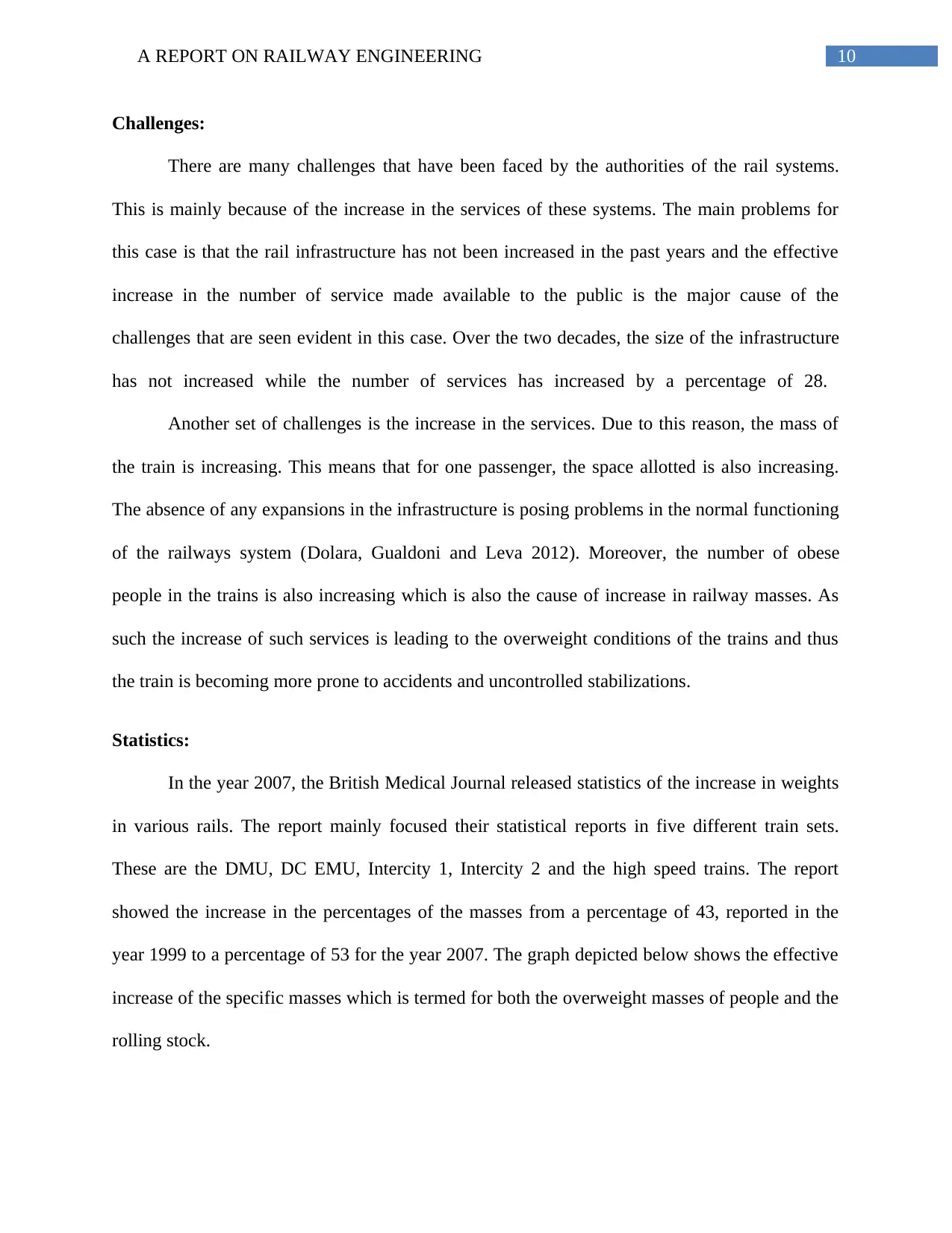
10A REPORT ON RAILWAY ENGINEERING
Challenges:
There are many challenges that have been faced by the authorities of the rail systems.
This is mainly because of the increase in the services of these systems. The main problems for
this case is that the rail infrastructure has not been increased in the past years and the effective
increase in the number of service made available to the public is the major cause of the
challenges that are seen evident in this case. Over the two decades, the size of the infrastructure
has not increased while the number of services has increased by a percentage of 28.
Another set of challenges is the increase in the services. Due to this reason, the mass of
the train is increasing. This means that for one passenger, the space allotted is also increasing.
The absence of any expansions in the infrastructure is posing problems in the normal functioning
of the railways system (Dolara, Gualdoni and Leva 2012). Moreover, the number of obese
people in the trains is also increasing which is also the cause of increase in railway masses. As
such the increase of such services is leading to the overweight conditions of the trains and thus
the train is becoming more prone to accidents and uncontrolled stabilizations.
Statistics:
In the year 2007, the British Medical Journal released statistics of the increase in weights
in various rails. The report mainly focused their statistical reports in five different train sets.
These are the DMU, DC EMU, Intercity 1, Intercity 2 and the high speed trains. The report
showed the increase in the percentages of the masses from a percentage of 43, reported in the
year 1999 to a percentage of 53 for the year 2007. The graph depicted below shows the effective
increase of the specific masses which is termed for both the overweight masses of people and the
rolling stock.
Challenges:
There are many challenges that have been faced by the authorities of the rail systems.
This is mainly because of the increase in the services of these systems. The main problems for
this case is that the rail infrastructure has not been increased in the past years and the effective
increase in the number of service made available to the public is the major cause of the
challenges that are seen evident in this case. Over the two decades, the size of the infrastructure
has not increased while the number of services has increased by a percentage of 28.
Another set of challenges is the increase in the services. Due to this reason, the mass of
the train is increasing. This means that for one passenger, the space allotted is also increasing.
The absence of any expansions in the infrastructure is posing problems in the normal functioning
of the railways system (Dolara, Gualdoni and Leva 2012). Moreover, the number of obese
people in the trains is also increasing which is also the cause of increase in railway masses. As
such the increase of such services is leading to the overweight conditions of the trains and thus
the train is becoming more prone to accidents and uncontrolled stabilizations.
Statistics:
In the year 2007, the British Medical Journal released statistics of the increase in weights
in various rails. The report mainly focused their statistical reports in five different train sets.
These are the DMU, DC EMU, Intercity 1, Intercity 2 and the high speed trains. The report
showed the increase in the percentages of the masses from a percentage of 43, reported in the
year 1999 to a percentage of 53 for the year 2007. The graph depicted below shows the effective
increase of the specific masses which is termed for both the overweight masses of people and the
rolling stock.
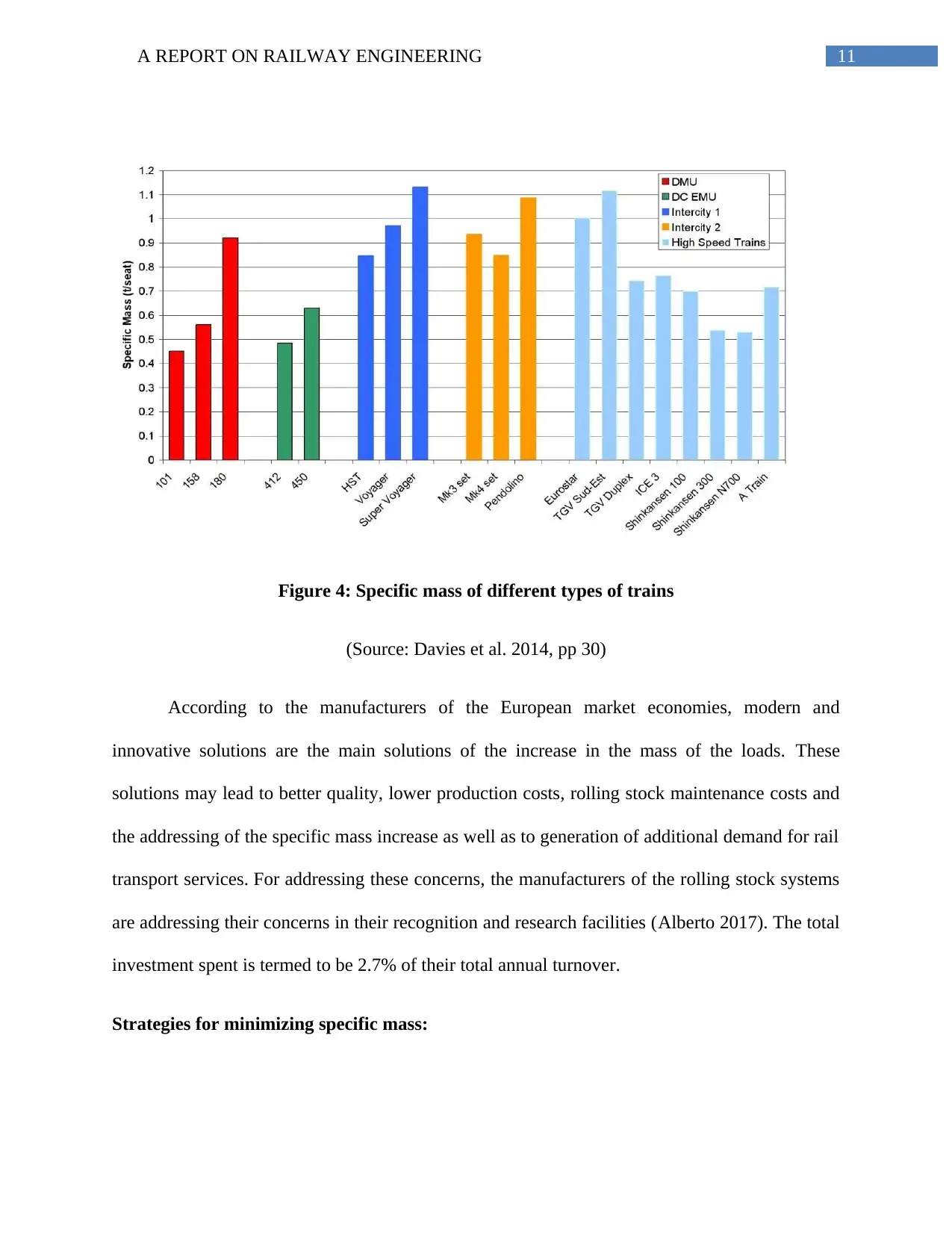
11A REPORT ON RAILWAY ENGINEERING
Figure 4: Specific mass of different types of trains
(Source: Davies et al. 2014, pp 30)
According to the manufacturers of the European market economies, modern and
innovative solutions are the main solutions of the increase in the mass of the loads. These
solutions may lead to better quality, lower production costs, rolling stock maintenance costs and
the addressing of the specific mass increase as well as to generation of additional demand for rail
transport services. For addressing these concerns, the manufacturers of the rolling stock systems
are addressing their concerns in their recognition and research facilities (Alberto 2017). The total
investment spent is termed to be 2.7% of their total annual turnover.
Strategies for minimizing specific mass:
Figure 4: Specific mass of different types of trains
(Source: Davies et al. 2014, pp 30)
According to the manufacturers of the European market economies, modern and
innovative solutions are the main solutions of the increase in the mass of the loads. These
solutions may lead to better quality, lower production costs, rolling stock maintenance costs and
the addressing of the specific mass increase as well as to generation of additional demand for rail
transport services. For addressing these concerns, the manufacturers of the rolling stock systems
are addressing their concerns in their recognition and research facilities (Alberto 2017). The total
investment spent is termed to be 2.7% of their total annual turnover.
Strategies for minimizing specific mass:
⊘ This is a preview!⊘
Do you want full access?
Subscribe today to unlock all pages.

Trusted by 1+ million students worldwide
1 out of 23
Related Documents
Your All-in-One AI-Powered Toolkit for Academic Success.
+13062052269
info@desklib.com
Available 24*7 on WhatsApp / Email
![[object Object]](/_next/static/media/star-bottom.7253800d.svg)
Unlock your academic potential
Copyright © 2020–2025 A2Z Services. All Rights Reserved. Developed and managed by ZUCOL.





